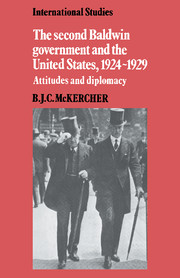Book contents
- Frontmatter
- Contents
- Acknowledgements
- List of abbreviations
- 1 THE SECOND BALDWIN GOVERNMENT AND THE UNITED STATES, NOVEMBER 1924–JUNE 1929
- 2 FOREIGN OFFICE PERCEPTION OF REPUBLICAN FOREIGN POLICY, NOVEMBER 1924–MAY 1927
- 3 THE ONSET OF NAVAL DEADLOCK, JUNE–AUGUST 1927
- 4 BELLIGERENT VERSUS NEUTRAL RIGHTS, AUGUST–DECEMBER 1927
- 5 THE PACT TO RENOUNCE WAR, JANUARY–JULY 1928
- 6 ARBITRATION, BELLIGERENT RIGHTS, AND DISARMAMENT, JANUARY–JULY 1928
- 7 THE CRISIS IN ANGLO-AMERICAN RELATIONS, AUGUST–NOVEMBER 1928
- 8 THE AMERICAN QUESTION RESOLVED, NOVEMBER 1928–JUNE 1929
- Notes
- Bibliography
- Index
1 - THE SECOND BALDWIN GOVERNMENT AND THE UNITED STATES, NOVEMBER 1924–JUNE 1929
Published online by Cambridge University Press: 10 November 2009
- Frontmatter
- Contents
- Acknowledgements
- List of abbreviations
- 1 THE SECOND BALDWIN GOVERNMENT AND THE UNITED STATES, NOVEMBER 1924–JUNE 1929
- 2 FOREIGN OFFICE PERCEPTION OF REPUBLICAN FOREIGN POLICY, NOVEMBER 1924–MAY 1927
- 3 THE ONSET OF NAVAL DEADLOCK, JUNE–AUGUST 1927
- 4 BELLIGERENT VERSUS NEUTRAL RIGHTS, AUGUST–DECEMBER 1927
- 5 THE PACT TO RENOUNCE WAR, JANUARY–JULY 1928
- 6 ARBITRATION, BELLIGERENT RIGHTS, AND DISARMAMENT, JANUARY–JULY 1928
- 7 THE CRISIS IN ANGLO-AMERICAN RELATIONS, AUGUST–NOVEMBER 1928
- 8 THE AMERICAN QUESTION RESOLVED, NOVEMBER 1928–JUNE 1929
- Notes
- Bibliography
- Index
Summary
Hitherto, so it seems to me, we have been inclined to deal with the United States from a wrong angle. We have treated them too much as blood relations, not sufficiently as a foreign country …
Foreign Office Memorandum, November 1927The essence of diplomatic history is not so much to discover what was actually happening in a period under study but, rather, to understand the way in which diplomatists beheld that reality. The key to understanding why the makers of foreign policy chose particular courses of action, that is, to see how they perceived the world and how in turn these perceptions led to policy, lies in an appreciation of their attitudes. A case in point concerns those who made British foreign policy during the period of Stanley Baldwin's second government and their attitudes towards the United States. During the life of that ministry, in the two years following the failure of the Coolidge naval conference in the summer of 1927, Anglo-American relations fell to their lowest point in this century. The discord that arose was political in nature and, as far as the Cabinet and the Foreign Office were concerned, derived from American foreign policies which threatened Britain's ability to defend itself and the Empire. Since the resolution of these differences was believed by the leaderships of both countries to be decisive for their futures as great Powers, an atmosphere of mutual suspicion and mistrust developed in which attempts at compromise became difficult.
- Type
- Chapter
- Information
- The Second Baldwin Government and the United States, 1924–1929Attitudes and Diplomacy, pp. 1 - 33Publisher: Cambridge University PressPrint publication year: 1984



